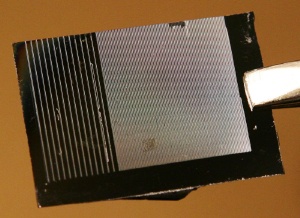Jun 9 2009
Nanoparticle films are no longer a delicate matter: Vanderbilt physicists have found a way to make them strong enough so they don't disintegrate at the slightest touch.
 A nanoparticle film made without additives demonstrates its cohesiveness by sitting on a ribbed surface without sagging. Image: Daniel Dubois
A nanoparticle film made without additives demonstrates its cohesiveness by sitting on a ribbed surface without sagging. Image: Daniel Dubois
In the last 25 years, ever since scientists figured out how to create nanoparticles - ultrafine particles with diameters less than 100 nanometers - they have come up with a number of different methods to mold them into thin films which have a variety of interesting potential applications ranging from semiconductor fabrication to drug delivery, solid state lighting to flexible television and computer displays.
Until now these films have had a common problem: lack of cohesion. Nanoparticles typically consist of an inorganic core coated with a thin layer of organic molecules. These particles are not very sticky so they don't form coherent thin films unless they are encapsulated in a polymer coating or mixed with molecules called chemical "cross-linkers" that act like glue to stick the nanoparticles together.
"Adding this extra material can complicate the fabrication of nanoparticle films and make them more expensive. In addition, the added material, usually a polymer, can modify the physical properties that make these films so interesting," says James Dickerson, assistant professor of physics at Vanderbilt, who headed the research group that developed freestanding nanoparticle films without any additives.
The properties of the new films and the method that the researchers use to create them is described in the article "Sacrificial layer electrophoretic deposition of freestanding multilayered nanoparticle films" published online in the journal Chemical Communications on May 27, 2009.
"Our films are so resilient that we can pick them up with a pair of tweezers and move them around on a surface without tearing," says Dickerson. "This makes it particularly easy to put them into microelectronic devices, such as computer chips."
Dickerson considers the most straightforward applications for his films to be in semiconductor manufacturing to aid in the continued miniaturization of digital circuitry and in the production of flexible television and computer screens.
A key component in the transistors in integrated circuits is an insulating layer that separates the gate, which turns current flow on and off, from the channel through which the current flows. Traditionally, semiconductor manufacturers have used silicon dioxide for this purpose. As transistors have shrunk, however, they have been forced to make this layer thinner and thinner until they reached the point where electrons leak through and sap the power from the device. This has led semiconductor manufacturers to retool their process to use "high-k" dielectric materials, such as hafnium oxide, because they have much higher electrical resistance.
"We have made high-k nanoparticle films that could be cheaper and more effective than the high-k materials the manufacturers are currently using," Dickerson says.
In addition, the physicist argues that the films have properties that make them ideal for flexible television and computer screens. They are very flexible and don't show any signs of cracking when they are flexed repeatedly. They are also made using a technique called electrophoretic deposition (EPD) that is well suited for creating patterned material and is compatible with fluorescent materials that can form the red, green and blue pixels used in flat panel television screens and computer displays.
EDP is a wet method. Nanoparticles are placed in a solution along with a pair of electrodes. When an electric current is applied, it creates an electrical field in the liquid that attracts the nanoparticles, which coat the electrodes. Using colloids, mixtures with particles 10 to 1,000 times larger than nanoparticles, EDP is widely used to apply coatings to complex metal parts such as automobile bodies, prosthetic devices, appliances and beverage containers. It is only recently that researchers like Dickerson have begun applying the technique to nanoparticles.
"The science of colloidal EDP is well known but the particles are substantially larger than the solvent molecules. Many nanoparticles, however, are about the same size as the solvent molecules, which makes the process considerably more complicated and difficult to control," Dickerson explains.
To get the method to work, in fact, Dickerson and his colleagues had to invent of new form of EDP, which they call sacrificial layer electrophoretic deposition. They added a spun-cast layer of polymer to the electrodes that serves as a pattern that organizes the nanoparticles as they are deposited. Then, after the deposition process is completed, they dissolve (sacrifice) the polymer layer to free the nanoparticle film.
According to the researchers, films made in this fashion stick together because the electrical field slams the nanoparticles into the film with sufficient force to pack the particles together tightly enough to allow naturally attractive inter-particle forces to bind the particles together.
So far the Dickerson group has used the technique to make films out of two different types of nanoparticles - iron oxide and cadmium selenide - and they believe the technique can be used with a wide variety of other nanoparticles.
"The technique is liberating because you can make these films from the materials you want and use them where you want," Dickerson says.
The co-authors on the paper are graduate students Saad A. Hasan and Dustin W. Kavich. The research was funded by a grant from Vanderbilt University.